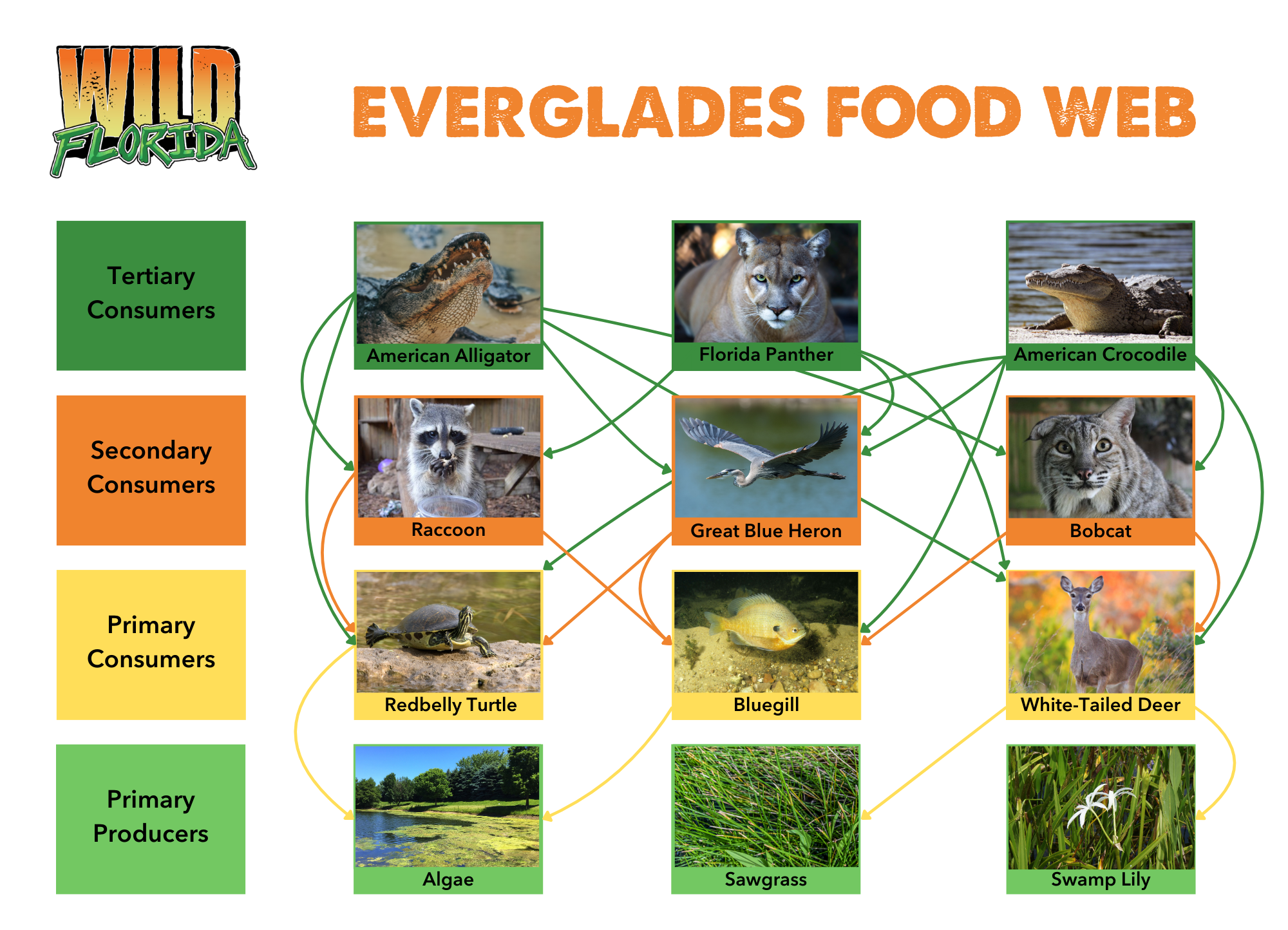The Florida Everglades is a unique ecosystem full of amazing animals and plants that create a complex food web. Discover the creatures making up the Everglades food web and the ones you might encounter on your next Wild Florida airboat tour!

What is a Food Web?
A food web diagram shows how different plants and animals in an ecosystem are connected by what they eat. Unlike a simple food chain, which follows a single path, a food web shows an ecosystem's many overlapping food chains. This helps us understand how energy flows from one organism to another and how they all depend on each other to survive. In the Everglades, the food web includes plants, herbivores, carnivores, omnivores, decomposers, and scavengers.
Florida Everglades Primary Producers
In the Everglades, primary producers are plants like sawgrass and algae. They are the foundation of the Everglades food web and support the entire ecosystem. The food web begins with the sun, as these primary producers transform the sun’s energy into their own food through photosynthesis.
The sawgrass plant has tall blades that dominate the landscape, providing food and shelter for many animals as a primary producer. Algae, another key producer, thrives in the water and supports numerous small animals like redbelly turtles, bluegill fish, and manatees. Producers also help create oxygen back into the environment and maintain the Everglades’ diverse environment.
Florida Everglades Primary Consumers
Primary consumers are herbivores that eat primary producers. This includes Florida Everglades animals as small as apple snails munching on algae to manatees, affectionately called sea cows, and chowing down on seagrass. Many aquatic animals, like the Florida redbelly turtle and the common bluegill, are primary consumers, eating much of the aquatic vegetation the Everglades has to offer. On land, native Florida animals like the marsh rabbit and white-tailed deer thrive by grazing on the abundant grasses and plants that make up the Everglades' rich landscape.
Florida Everglades Secondary Consumers

Secondary consumers are the carnivores and omnivores that keep the herbivore populations in check. In the Everglades, raccoons are opportunistic omnivores, eating both plants and primary consumers like insects and small animals. Water snakes and predatory birds like the great blue heron also join the feast, preying on fish, amphibians, and small mammals. Another fierce Everglades predator is the bobcat. Unlike the endangered Florida panther, bobcats are very common in the Everglades, often hunting rabbits, squirrels, and even deer.
Florida Everglades Tertiary Consumers
 Tertiary consumers are carnivores that feast on secondary consumers. They are the apex predators, ruling the top of the food web. The American alligator is the king of the Everglades, preying on a variety of animals, including fish, birds, and mammals. While often overshadowed by the more famous American alligator, the American crocodile is a highly opportunistic feeder. Unlike alligators, crocodiles could hunt in brackish and saltwater environments for both aquatic animals and small land mammals. The Florida panther, another top predator, hunts for deer and wild hogs. You can visit our resident Florida panther, Nala, to learn more about this critically endangered yet important animal to the Everglades food web.
Tertiary consumers are carnivores that feast on secondary consumers. They are the apex predators, ruling the top of the food web. The American alligator is the king of the Everglades, preying on a variety of animals, including fish, birds, and mammals. While often overshadowed by the more famous American alligator, the American crocodile is a highly opportunistic feeder. Unlike alligators, crocodiles could hunt in brackish and saltwater environments for both aquatic animals and small land mammals. The Florida panther, another top predator, hunts for deer and wild hogs. You can visit our resident Florida panther, Nala, to learn more about this critically endangered yet important animal to the Everglades food web.
Florida Everglades Decomposers
Decomposers are the unsung heroes of the Everglades, breaking down dead plants and animals. This part of the Everglades food web recycles nutrients back into the ecosystem. Fungi, bacteria, earthworms, and certain insects tirelessly work behind the scenes to ensure that nutrients are continuously cycled, supporting the growth of primary producers.
The Invasive Python
One of the most significant disruptions to the Everglades food web comes from the invasive Burmese python. Originally native to Southeast Asia, these snakes were introduced to the Everglades through the pet trade. Burmese pythons pose a major threat to the Everglades ecosystem because they prey on a wide variety of animals, including mammals, birds, and reptiles.
With no natural predators, the python population has exploded, drastically reducing the number of native species. Many native Florida animals are quickly disappearing from the Everglades, including rabbits, raccoons, and bobcats. Even the Everglades’ top predator, the American alligator, has fallen prey to pythons.
The Everglades is a beautiful ecosystem with a rich history and a vast variety of wildlife. Problems like the python population are only one reason why conservation and education are so important to help keep this ecosystem thriving. At Wild Florida, we'd love to show you how abundant Florida’s natural beauty can be with one of our airboat tours along the headwaters of the Florida Everglades. Included with your airboat ticket is admission to our Gator Park, where you can see and even meet several animals from the Everglades food web!



